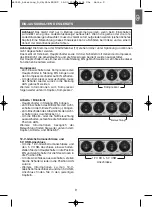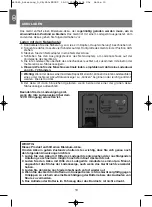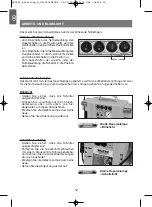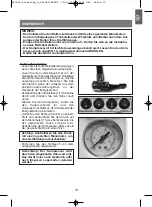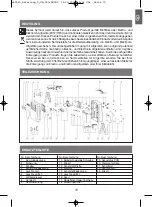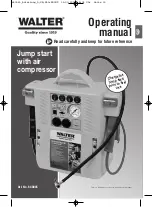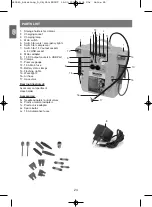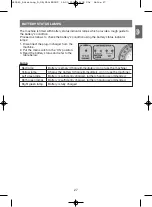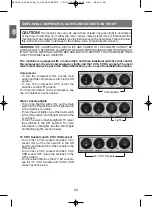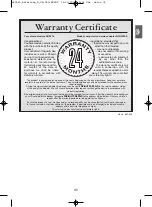
21
j. Study your vehicle’s engine and keep well away from any hot, moving or potentially moving
parts such as fan blades, belts, pulleys and other parts that can cause injury to persons. Tie
up long hair and do not wear loose fitting clothes or jewellery.
12.
PREPARING TO JUMP START
a. Do not remove your vehicle’s battery from the vehicle when jump starting the vehicle.
b. Be sure area around the battery is well ventilated when jump starting the vehicle.
c. Clean battery terminals. Be careful to keep corrosion from coming into contact with your eyes.
d. Study the car battery manufacturer’s specific precautions and follow these.
e. Consult your vehicle’s owner’s manual and follow any instructions on jump starting contained
within. Some modern vehicles with computerized electrical systems may not allow jump
starting.
f. Determine voltage of battery by referring to your car's owner’s manual and make sure that it
matches the rating of this device. This device may only be used to jump start cars with a 12
V battery and electrical system.
13.
JUMP STARTER LOCATION
a. Locate the jump starter as far away from your vehicle’s battery as the starter cables permit.
b. Never place jump starter directly above your car battery when jump starting; gases from
battery will corrode and damage the jump starter.
c. Do not operate the jump starter in any closed-in area or restrict ventilation in any way.
14.
DC CONNECTION PRECAUTIONS
a. Do not connect or disconnect DC output clips (starter cables) while the device is connected
to the plug-in charger. Never allow the clips to touch each other.
b. Attach clips to battery and chassis as indicated in 15(e) and 15(f).
15.
FOLLOW THESE STEPS WHEN JUMP STARTING YOUR VEHICLE. A SPARK NEAR BATTERY MAY
CAUSE BATTERY EXPLOSION. TO REDUCE RISK OF A SPARK NEAR BATTERY:
a. Position AC and DC cords to reduce risk of damage by your car's bonnet, door, or moving engine
part.
b. Stay clear of fan blades, belts, pulleys, and other parts that can cause injury to persons.
c. Check polarity or battery posts.
POSITIVE (POS, P, +)
usually has larger diameter than
NEGATIVE (NEG, N, –)
post.
d. Determine which post of the battery is grounded (connected) to the chassis. If the negative
post is grounded to chassis (as in most vehicles) see (e). If the positive post is grounded to
the chassis to (f).
e. For negative-grounded vehicle,
FIRST
connect the
POSITIVE (RED)
clip to
POSTIVE (POS, P, +)
ungrounded post of the battery.
SECOND
connect the
NEGATIVE (BLACK)
clip to vehicle
chassis or engine block away from the battery. Do not connect clip to the carburetor, fuel lines,
or sheet metal body parts. Connect to a heavy gauge metal part of the frame or engine block.
f. For positive-grounded vehicle,
FIRST
connect the
NEGATIVE (BLACK)
clip to
NEGATIVE (NEG, N, -)
ungrounded post of the battery.
SECOND
connect the
POSITVE (RED)
clip to vehicle chassis
or engine block away from the battery. Do not connect clip to the carburetor, fuel lines, or sheet
metal body parts. Connect to a heavy gauge metal part of the frame or engine block.
g. When disconnecting the jump start, proceed in REVERSE ORDER.
GB
640045_Anleitung_D,GB,SLO:PRINT 14.03.2016 8:34 Uhr Seite 21
Summary of Contents for NFQ2020A
Page 17: ...17 D 640045_Anleitung_D GB SLO PRINT 14 03 2016 8 34 Uhr Seite 17...
Page 18: ...18 D 640045_Anleitung_D GB SLO PRINT 14 03 2016 8 34 Uhr Seite 18...
Page 36: ...36 GB 640045_Anleitung_D GB SLO PRINT 14 03 2016 8 34 Uhr Seite 36...
Page 53: ...53 SLO 640045_Anleitung_D GB SLO PRINT 14 03 2016 8 34 Uhr Seite 53...
Page 54: ...640045_Anleitung_D GB SLO PRINT 14 03 2016 8 34 Uhr Seite 54...
Page 55: ...640045_Anleitung_D GB SLO PRINT 14 03 2016 8 34 Uhr Seite 55...



